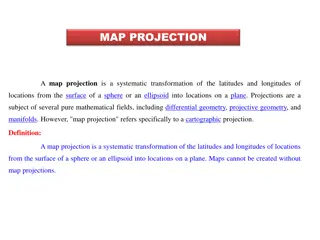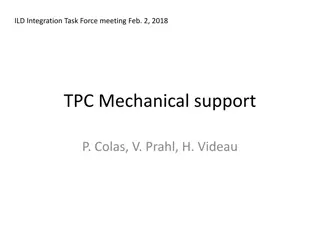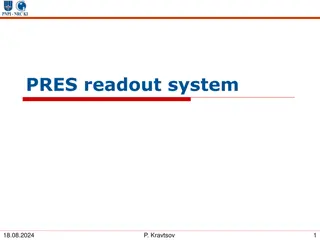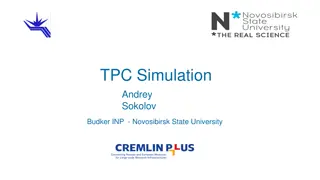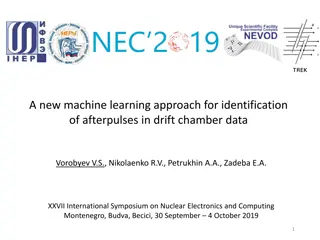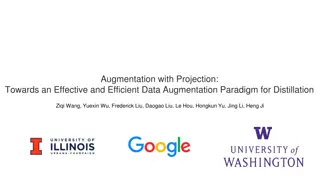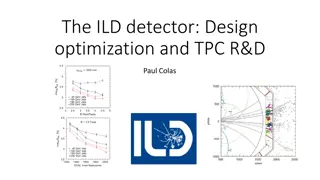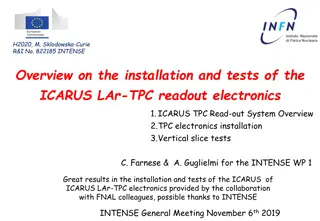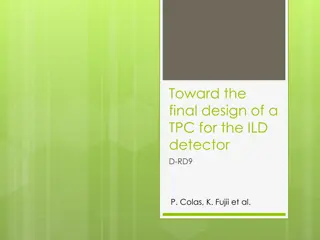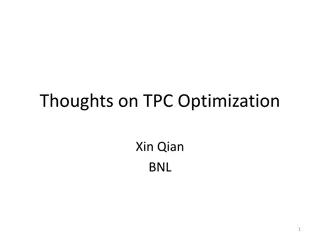Understanding Electroluminescence Time Projection Chamber (EL TPC) Physics
Delve into the fundamentals of Electroluminescence Time Projection Chambers (EL TPCs) through concepts like electron drift, scintillation mechanisms in noble gases, and charge yield estimation. Explore the workings of EL TPC prototypes, such as ZEPLIN II/III and DarkSide, for applications like reactor monitoring and WIMP searches. Discover the significance of EL TPCs in discriminating nuclear recoils, tracking energy resolutions, and leveraging scintillation mechanisms in gases like argon.
Download Presentation

Please find below an Image/Link to download the presentation.
The content on the website is provided AS IS for your information and personal use only. It may not be sold, licensed, or shared on other websites without obtaining consent from the author. Download presentation by click this link. If you encounter any issues during the download, it is possible that the publisher has removed the file from their server.
E N D
Presentation Transcript
Basics of an Electroluminescence Time Projection Chamber (EL TPC) EDIT 2012 Fundamentals Group: James White, Clement Sofka, Andrew Sonnenschien, Lauren Hsu, Ben Loer, Chris Stoughton, Fritz Dejongh, Hugh Lippincott, Jong Hee Yoo
LESSON Concept of Electroluminescent Time Projection Chamber (EL TPC) uniform drift field and parallel plate EL gap Scintillation mechanism in noble gases Electron drift and diffusion in gases Electroluminescence: aka light gain / proportional scintillation Estimate charge yield of alpha in argon gas Estimate EL yield Will study the concept using a toy: EL TPCito
EL TPC Physics Detectors ZEPLIN II/III XENON 10/100 LUX WARP DarkSide PANDA-X NEXT-100 many other prototypes for reactor monitoring, homeland defense, medical two-phase xenon WIMP search two-phase xenon WIMP search two-phase xenon WIMP search two-phase argon WIMP search two-phase argon WIMP search two-phase xenon WIMP search high pressure xenon 0 search
Concept How does it work? Gamma (for example) Light detectors Anode EL Gap Electroluminescence (S2) Gate Electron drift Interaction and Drift Region E-field Deposits energy Flash of scintillation (S1) Cathode Time S1 S2
Example: LUX 50 cm 50 cm
e.g. High Pressure Xenon TPC Neutron (or WIMP) 60 keV Gamma S1 S2 30 keV e- 30 keV X-ray 30 keV e-
Why use an EL TPC? NR discrimination Tracking electron recoils nuclear recoils 241Am 137Cs 30 keV Energy Resolution 662 keV
Scintillation Mechanism e.g.Argon ~1 bar (Similar in other noble gases) Atom excited by particle interaction: Ar* + 2Ar Ar2* + Ar Ar2* 2Ar + h And, recombination can produce light: Ar+ + e- Ar* 128 nm
Argon Scintillation (cont) Fast component (singlet) Penning effect Slow component (triplet) Example of alpha-induced scintillation (S1) in pure argon at P ~ 50 bar with zero drift field. (Summed pulses from a high pressure test cell at TAMU.) Similar, but single event with a trace of xenon. Interaction with impurity atoms greatly alters pulse shape.
Electron Drift With no electric field, liberated electrons will obtain a Boltzmann energy distribution E ~ kT - some will recombine with the positive ions. http://garfield.web.cern.ch/garfield/help/garfield_41.html#Ref0347 With an electric field E present, electrons will drift with velocity v ~ E, where is the electron mobility in the gas ( is a function of density, gas mixture etc.) elastic ionization In presence of E, electrons heat up and average energy of collision increases. excitation Ramsauer minimum The mean-free-path between collisions, = 1/( n) where is the collision cross section and n is the number density of gas atoms. Cross section for electron collisions in argon
Electron Drift (cont) Example: ~ 4 E-16 cm2 and n ~ 3 E19 /cm3 = 1/(4E-16 * 3E19) ~ 8E-5 cm ~ 800 nm But ~ 1 E-17 cm2 and n ~ 3 E19 /cm3 = 1/(1E-17 * 3E19) ~ 3E-3 cm ~ 30 m note Atomic spacing is ~ 1/(3E19)1/3 ~ 3E-7 cm ~ 3 nm Ar 1 bar Garfield/Magboltz output ArN2(0.2%) 1 bar Electron energy distribution in pure argon, Edrift = 326 V/cm
Electron Diffusion 4.5 cm = (2Dt)1/2 Pure Argon 1 bar, 326 V/cm Argon 99.8% N2 0.2%
Electroluminescence At some value of E, the energy of drifting electrons can exceed energy needed to excite atoms Note, these are above excitation threshold but below ionization threshold. Excitation Threshold 11.6 ev Ionization Threshold 15.7 eV This allows optimum energy resolution because there are no fluctuations added due to ionization process Argon: 1 bar, 2133 V/cm
Electroluminescence Yield in argon Example: say N ~ 3 E19 atoms/cc E = 2100 V/cm E/N = 7E-17 V cm2 atom-1 Y/N ~ 0.4E-17 ph cm2 /e-/atom So Y = N*Y/N ~ 120 ph/e-/cm http://hdl.handle.net/10316/1463 Thesis of C.M.B. Monteiro, U. Coimbra
EL TPCito PMT TPB-coated window 1.5 cm Anode grid HD polyethylene vessel 4.6 cm Gate grid Field rings Cathode HV Feed-thrus
EL TPCito (cont) source location
Electro-statics Electric Field Lines Electric Potential EL gap Drift region
Alpha Signal estimate charge yield 241Am Source E_alpha ~ 5.4 MeV but,Am covered with 0.0002 cm Au stopping power in Au ~ 220 MeV cm2/g SO energy loss ~ 220 * 19g/cc*.0002 cm looses about 0.8 MeV http://www.nist.gov/pml/data/star/index.cfm Stopping power: alphas in argon E_Alpha 5.4 -0.8 ~ 4.6 MeV Assuming there is no further material between the source and the drift region: Argon: density =1.7E-03 g/cc E_alpha ~ 4.6 MeV Projected Range ~ 7.3E-3g/cm2 Distance ~ 7.3E-3/ 1.7E-3 ~ 4.2 cm W ~ 26.5 ev/ion 4.6E6 ev/26.5 ev/ion ~ 170 k ions/alpha excluding distance from source to drift region, est~ 150 k ions drifting
Alpha Signal estimate light yield Light Yield? D PMT N_ions ~ 150k/alpha Y ~ 120 ph/e-/cm x 1.5 cm EL gap = 180 ph/e- PMMA d TPB coating EL Gap Produce ~ N*Y ~ 2.7E7 128 nm sinto 4 But how many will we detect? Back-of-envelope estimate: PMT: D=5 cm d ~ 2.5 cm Asph=4 d2 APMT= D2/4 First, need special window and PMT to detect 128 nm directly (e.g. MgF2 window and PMT) So, use VUV to blue WLS (wavelength shifter) / ~~ APMT/Asph ~ D2/(16d2) ~ .25 TPB: 100% conversion, 50% go up, 50% down QE of PMT ~ 0.2 in blue Efficiency ~ / *QE*.5(TPB effect) ~ .25*.2*.5 = 1/40 ~ 2.5% So Detect ~ 2.7E7*.025 = 7E5 pe (photoelectrons) Tetraphenyl - Butadiene (TPB) Est 100% conversion efficiency
Example Signal S1 S2 Drift time
Construction mesh placed on field rings field rings on cathode hd polyethylene housing with TPB-coated acrylic window 88% 0pen ss mesh anode and gate
PLAN add alpha source and close dark box turn on gas flow first pure argon Apply HV to PMT and observe single electron dark current on oscilloscope bias cathode to -1500 bias gate grid to 0 V raise anode voltage to ~ 3000 V and observe S1 & S2 signals Is drift time from S1 to start of S2 what you expect? vary drift field and EL field observe changes vary gas mixture add ~ 0.2% N2 observe change in light yield, drift time and pulse width discuss measure area of single electron pulse this is tricky! measure area of S2 pulse measure light yield still tricky! Is light yield reasonable considering back of envelope estimate? Last, will try window without wavelength shifter what will happen? View internals of toy detector Assemble HV & signal cables, gas lines, and PMT in dark box






